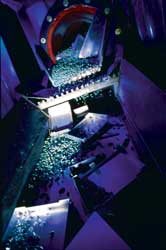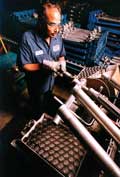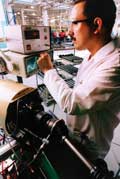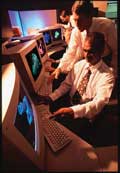|
Remanufacturing: The Original
Recycling
© AAIA 2002. Aftermarket Insider, Vol.
16.
by Leslie Toussaint
|
Ten or 15 years ago, auto
technicians would rebuild hard parts for
customers right in the shop. Today, that system
doesn’t work, because consumers don’t have time
to wait and don’t want to pay for the additional
labor. Remanufacturing now solves these
problems, and as such, it is one of the largest
product categories in the automotive
aftermarket. The entire remanufacturing industry
generates approximately $65 billion in sales,
with the automotive segment representing $37
billion of that total. |
|
 |
“This industry is a
balancing act, and the business itself is not
glamorous,” said Rick Andrulis, executive vice
president of sales and marketing at Springfield
Remanufacturing. “You never sacrifice quality for
cost considerations, so the margins are tight.”
Remanufacturing begins with
a greasy core that needs cleaning. This duty
generally falls to entry-level people, who learn
the business by doing the disassembly. Cores
consist of hard parts such as engine blocks,
crank- shafts, valves, rod bearings and cam
shafts. High-wear components such as sleeves,
gaskets and bearings are always replaced.
Cleaner, Better,
Cheaper
Remanufacturers can correct
product flaws that occur after the typical
50,000-mile OEM warranty expires. The cost for a
remanufactured part is generally 30-50 percent of
what a new part would cost, because labor, energy
and raw materials are conserved. Bill Gager,
president and CEO of the Automotive Parts
Rebuilders Association, said remanufacturing uses
between 80 and 85 percent less energy than
producing a new part. Labor, machining, and raw
materials are saved, while chemical waste and
energy consumption are drastically reduced — all
of which help keep operations lean.
“Much of the cost savings
can be attributed to the fact that the price of
initial tooling and development are not in the
remanufactured unit,” said Tony Perticari, vice
president of sales and marketing at Crown
Remanufacturing, Inc. “This is not to say that we
do not tool up for parts which are not readily
available in the aftermarket. We simply salvage a
good deal of the core, and this keeps the cost
down.”
“The OEs don’t give much
credence to problems which are not large enough to
cause a recall, whereas the remanufacturing
industry can address very specific, short-run
engineering flaws,” said David Deegan, vice
president at Engine Lab of Tampa, Inc. In fact,
OEs frequently look to remanufacturer suppliers to
solve reoccurring part failures.
“Besides the cost savings,
many remanufactured parts carry extensive
warranties to boost consumer confidence,”
Perticari said. “This business has been around for
50 to 60 years, and most of the major companies
possess the same sophistication and QS/ISO
certification as tier one suppliers.”
Environmentally Friendly
The average car owner is
unaware of the environmental benefits of a
remanufactured part. “There is a whole green pitch
that the remanufacturing sector has overlooked for
years. Consumers want eco-friendly products, and
there’s data showing that green companies grow
faster than their competitors,” said Michael
Cardone, Jr., president & CEO of Cardone
Industries, Inc.
“While it’s difficult to get
people to spend money on recycling, it’s easy to
sell remanufactured goods because the cost is
lower. People don’t realize that they’re spending
on recycling,” Deegan said.
|
The cost for a remanufactured part
is generally 30-50 percent of what a new part
would cost, because labor, energy and raw
materials are conserved. |
|
 |
Consumer Education
The Automotive Repower
Council is in the process of developing a national
campaign to educate consumers about
remanufacturing. By gathering feedback from
consumer focus groups and distributors and
installers, they hope to devise a message that
will help consumers understand the value of
remanufactured parts.
“The industry is under a
shade tree when it comes to consumer awareness. I
don’t think most consumers realize how much of a
remanufactured part is actually new. By the same
token, many consumers will think they’re getting a
brand-new engine, when in fact, they are buying
remanufactured,” Andrulis said. Up to 90 percent
of the replacement engines, transmissions, CV
joints, starters, rack and pinion units, brakes,
and alternators available on the market are
remanufactured.
Legislative Challenges
New parts are installed on
new vehicles, where they eventually fail due to
normal wear and tear, or design weaknesses. The
cores then go to a remanufacturer, who rebuilds
the part and puts it back on a vehicle. This can
go on in perpetuity, unless the cycle is
interrupted.
The vehicle scrappage
provision in the Energy Policy Act of 2002 (S.517)
recently defeated by the Senate would have
threatened this cycle. The act authorized federal
grants to state programs that provide monetary
incentives for motorists to scrap vehicles 15
years old and older. This legislation would have
hurt the industry on many levels, from taking
cores out of circulation to eliminating the
aftermarket’s prime customer base of older
vehicles.
“Nearly half of the vehicle
population in the U.S. is 10 years old, or older,
so it would have greatly impacted the industry.
The legislation would have hurt low-income people,
who can’t afford new cars, and the environment
because the average fuel economy of a new vehicle
is much lower than it was 15 years ago,” said
APRA’s Gager.
Europe’s end-of-life vehicle
directives require OEs to take back their products
at the end of their lifecycle, and reuse all
salvageable materials. “In the U.S., we already
have this system in place through our
remanufacturing sector,” Cardone said. “If
anything, we ought to focus on creating more
stringent requirements for the handling of
scrapped vehicles to insure the recycling of
cores.”
“Right now we see the bulk
of our sales in the four- to 10-year-old vehicle
category,” Perticari said. “However when you
consider the improved quality of the vehicles
produced today and the longer warranties offered,
it is conceivable that cars will be on the road
for 20 years or longer in the near future.”
Legislation surrounding
on-board diagnostics, or OBD II, is the other
major challenge facing the industry. Aftermarket
manufacturers and remanufacturers must have access
to critical OBD II service tools and information
in order to produce components that will operate
properly with the vehicles’ sophisticated on-board
computers. However, the OEMs are fighting to
maintain total control of the software driving OBD
II, and other electronic control units.
“The danger with OBD II is
that the OE suppliers are contractually bound to
withhold design specs from the independent
aftermarket for a given number of years,” said
Deegan. “We also face problems with component
sourcing. We’re seeing some major engine repairs
on 2000-01 models already, but 70-80 percent of
the parts needed to do those repairs have to come
from the OEs, which affects my pricing.”
Of course, necessity is the
mother of invention, and there are those in the
industry who see opportunities in government
regulation. “Most businesses groan when the
government raises standards and piles on
regulations, but I see it as a challenge. Make it
tougher, we’ll just stay one step ahead,” Cardone
said.
Andrulis, who serves the
heavy duty and agricultural markets, believes that
environmental legislation has actually helped his
business. “While you can’t install a
non-EPA-certified engine in a truck, there’s
nothing to stop you from re-tooling the existing
one. In the EPA’s view, all we’re doing is
supporting an existing product line.”
 |
|
Catastrophic part failures are
diminishing, to the point where eventually
products won’t
fail. |
Constant Innovations
The biggest challenge
currently facing the remanufacturing industry is
finding a way to rebuild the electronic and
hydraulic systems installed on today’s cars. “We
frequently remanufacture electronic control units
that were engineered 10, 15, 20 years ago. As a
matter of course, the units are upgraded with
current technologies, and our customers benefit
from the improved performance and durability of
the resulting product,” Perticari said.
A few years ago, a Cardone
customer discovered a problem in one of his
electronic control units. Repairing the unit
involved replacing all 270 resistors on the
circuit board, which took days to accomplish by
hand. Rather than give up, Cardone’s engineering
department developed the ASR 9000 robot, which is
able to replace the chips in 15 minutes. “We’ve
invested millions in develop-ing custom tools and
processes. ABS systems and electronic control
units are very complicated, but in some cases
remanufacturing is the only option for repair,
because the technology changes every 18 months,”
Cardone said.
“Crown is always looking for
ways to improve the sealing properties on
hydraulic units,” Perticari said. “Newer and more
environmentally-friendly methods of cleaning and
recycling waste are also important to any quality
remanufacturer.”
Some remanufacturers offer
what is known as rebuild and return, or the
R&R option. This process tracks the components
of a core through the remanufacturing system, so
that the original part is returned to the
customer. Classic car enthusiasts favor this
method because they have a sizable investment in
maintaining the original parts on their vehicle.
Trimming the Fat
Lean remanufacturing means
doing things faster by increasing efficiency in
operations. To help companies adopt lean
strategies, the Rochester Institute of Technology
began offering a university program, specially
tailored for remanufacturers, which teaches
cleaning, assembly and testing techniques. The
National Center for Reman-ufacturing and Resource
Recovery is another organization that helps small
to mid-sized companies who may not have the
in-house resources to tackle industry
issues.
“One thing we’re looking
into is helping companies diversify their product
offerings to cushion against slumps in the
automotive market,” said Gager. “We’re looking at
how we can streamline the process of turning a
used core into a finished product, while
simultaneously shrinking the margins of error that
cause product failure.” Warranty returns are
another headache. Often a product is returned with
no detectable flaws. This is usually the result of
poor diagnostics at the installer level, according
to Gager.
“Product consolidation is an
ongoing process by which we seek to reduce the
number of SKUs our customers stock, while not
compromising the coverage and availability they
need to serve the repair sector,” Perticari said.
“The bottom line is we cannot afford to have
non-value- added costs in our products.”
“Catastrophic part failures
are diminishing, to the point where eventually
products won’t fail. In a sense, the industry is
working towards its own demise,” said Andrulis.
“We’re already looking to shift some of our
business to Third World markets, where the vehicle
population is older.”
 |
|
Up to 90 percent of the
replacement engines, transmissions, CV joints,
starters, rack and pinion units, brakes, and
alternators available on the market are
remanufactured. |
Salvaging the Future
As the computerized content
of vehicles increases, mechanical components are
being replaced by electronically controlled
systems, and the remanufacturing process grows
ever more complex. Reman industry experts agree
that to stay ahead of the competition businesses
must constantly improve processes in order to
prevent costly ergonomics injuries, reduce
inventory, and recycle as much core content as
possible. Or to borrow the words of one Cardone
employee, “salvage, salvage, salvage!”
To contact the Automotive
Parts Rebuilders Association, visit www.apra.org
or call 703-968-2772. The National Center for
Remanufacturing and Resource Recovery (NCR³) at
Rochester Institute of Technology can be reached
at 585-475-6091 or www.reman.rit.edu. For more
information on the Automotive Repower Council,
call 866-473-7693 or visit
www.repower.org.
|